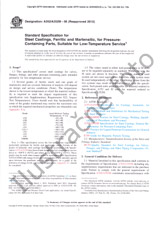Potrebujeme váš súhlas na využitie jednotlivých dát, aby sa vám okrem iného mohli ukazovať informácie týkajúce sa vašich záujmov. Súhlas udelíte kliknutím na tlačidlo „OK“.
ASTM F3369-19
Standard Guide for Assessing the Skeletal Myoblast Phenotype
NORMA vydaná dňa 1.2.2019
Informácie o norme:
Označenie normy: ASTM F3369-19
Poznámka: NEPLATNÁ
Dátum vydania normy: 1.2.2019
Kód tovaru: NS-946453
Počet strán: 9
Približná hmotnosť: 27 g (0.06 libier)
Krajina: Americká technická norma
Kategória: Technické normy ASTM
Anotácia textu normy ASTM F3369-19 :
Keywords:
myoblasts, myogenic progenitor cells, myotubes, satellite cells, stem cells,
Doplňujúce informácie
| Significance and Use |
|
5.1 This guide describes markers involved in myoblast differentiation that can be used to screen stem cells to help define myogenic capacity. Stem cells include pluripotent and multipotent stem cells capable of differentiating into several different mesenchymal cells, including skeletal muscle myoblasts. 5.2 To assess myogenesis in cells derived and not derived from muscle, markers are measured to accurately define the changes in transcription and structural proteins that regulate differentiation, fusion, and myotube formation. Discussion of these markers is important to understand why they are recommended. 5.3 Myogenic Differentiation: 5.3.1 Myogenic differentiation is a highly regulated process controlled by paired box (Pax) transcription factors and the myogenic regulatory factor (MRF) family. During early differentiation in adults, myogenic progenitors such as activated satellite cells or myoblasts express 5.4 Forming Myotubes: 5.4.1 While myogenic markers describe differentiation, fusion into multinucleated myotubes is an important factor in muscle biology. Myoblasts differentiate into a fusogenic phenotype characterized by multiple fusion markers. One marker of note is m-cadherin. M-cadherin is reported to be involved in myoblast fusion and to regulate myotube development (4). Therefore, assessment of fusion markers in addition to myogenic differentiation markers would favor a cell phenotype capable of forming muscle. In support of this, studies have shown that despite expression of myogenic differentiation genes, cells not expressing m-cadherin were unable to fuse and form muscle. These results suggest that in addition to myogenic differentiation markers, fusion markers should be considered given their importance as indicators of whether a cell is able to fuse 1.1 Myogenic differentiation is a process regulated by specific transcription factors and signaling molecules that have been shown to induce a myogenic phenotype. Transcription factors mark the stages of myogenesis and act as benchmarks for use in myogenic assays. 1.2 This guide applies to mammalian cells but does not apply to non-mammalian cells as the myogenic markers for non-mammalian cells can be different than those described here. 1.3 This guide proposes appropriate markers to measure when conducting myogenic differentiation assays. This guide describes the stages for multipotent stem cell differentiation toward myoblasts and myotubes. This guide provides information about the appropriate methods to determine myogenic differentiation. This guide does not provide information about media, supplements, or substrates that drive differentiation toward a myogenic phenotype. 1.4 The purpose of this guide is to act as an aid for work performed in the area of skeletal myogenesis. Using this guide, researchers should be able to understand which skeletal muscle markers are best suited for experiments. This guide will improve consistency for studies of myogenic differentiation of multipotent stem cells by identifying appropriate markers for each stage leading to myocyte differentiation. It should be noted that myoblast differentiation in vitro may not be predictive of results that may be obtained 1.5 This standard does not purport to address all of the safety concerns, if any, associated with its use. It is the responsibility of the user of this standard to establish appropriate safety, health, and environmental practices and determine the applicability of regulatory limitations prior to use. 1.6 This international standard was developed in accordance with internationally recognized principles on standardization established in the Decision on Principles for the Development of International Standards, Guides and Recommendations issued by the World Trade Organization Technical Barriers to Trade (TBT) Committee. |




 Cookies
Cookies
